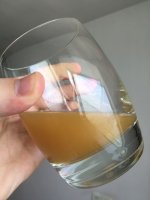Mofo
Grandmaster Brewer
A couple weeks ago I brewed my 20th all-grain beer. It was the American Pale Ale recipe from Brewing Classic Styles. It was the second time I’ve brewed it in as many months. It’s destined for the drain; the first batch of beer I’ll dump. It looks like mud water and tastes about as pleasant.
(For the record, I’m still enjoying bottles of the first batch; it turned out fine.)
The first I noticed something might be wrong was during the chill. Even though I was nearing 20C some 25 minutes after knockout, there was no cold break. To chill, I stir a whirlpool with an immersion chiller. Usually, when I get around 26C, I can see the cold break start to settle if I stop stirring. This time I saw no change in the complexion of the wort. It looked normal when boiling 20 minutes earlier but now that it was cooled it looked like muddy water. And after reaching an FG of 1.012 it still looks like muddy water (see pic).
The only thing that went differently from from when I brewed this a month earlier (other than a couple degrees difference in mashing) was a slight boil-over immediately after hot break. I see no change in my grains. They've been kept cool and dry. I used the same bottled water I always use. I had a new brass nozzle attached to the ball valve on my brew kettle, but surely that didn't cause it.
Is there some obvious cause for this that I’ve missed in the literature? Or do I need to do more painstaking forensic work?
(For the record, I’m still enjoying bottles of the first batch; it turned out fine.)
The first I noticed something might be wrong was during the chill. Even though I was nearing 20C some 25 minutes after knockout, there was no cold break. To chill, I stir a whirlpool with an immersion chiller. Usually, when I get around 26C, I can see the cold break start to settle if I stop stirring. This time I saw no change in the complexion of the wort. It looked normal when boiling 20 minutes earlier but now that it was cooled it looked like muddy water. And after reaching an FG of 1.012 it still looks like muddy water (see pic).
The only thing that went differently from from when I brewed this a month earlier (other than a couple degrees difference in mashing) was a slight boil-over immediately after hot break. I see no change in my grains. They've been kept cool and dry. I used the same bottled water I always use. I had a new brass nozzle attached to the ball valve on my brew kettle, but surely that didn't cause it.
Is there some obvious cause for this that I’ve missed in the literature? Or do I need to do more painstaking forensic work?

